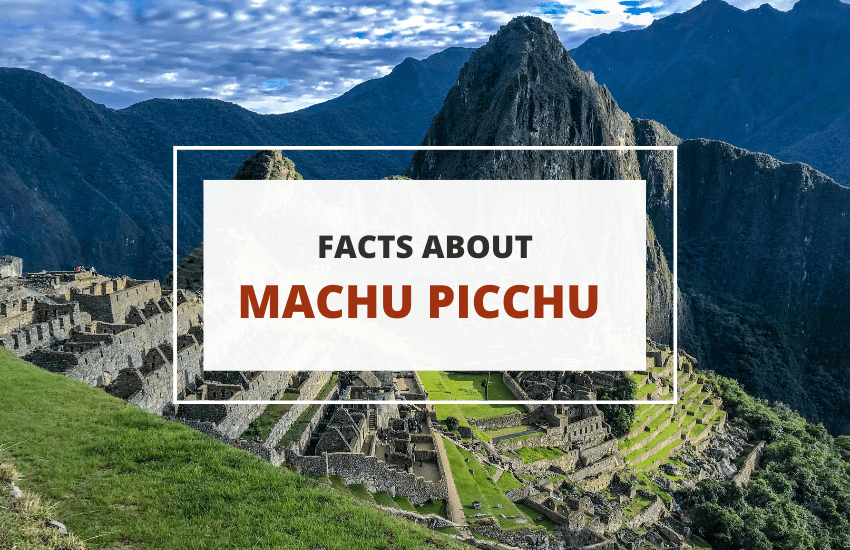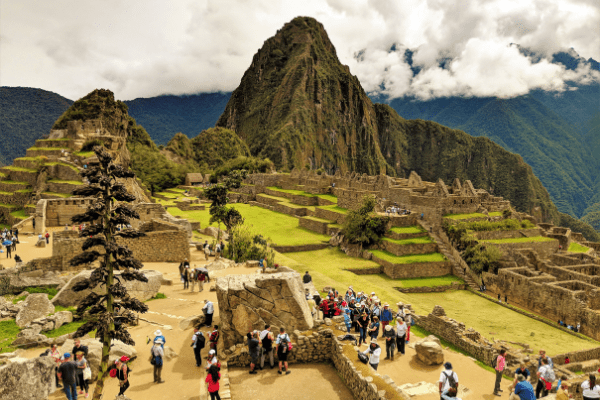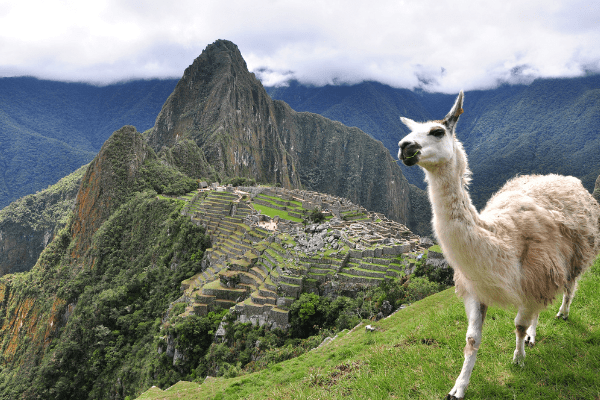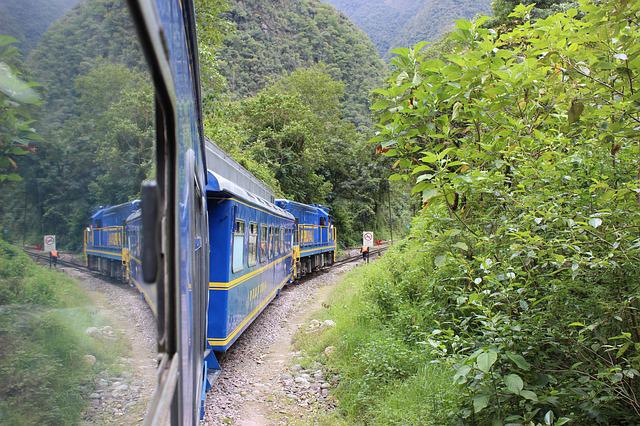
Table of Contents
The Inca Empire has been a thing of legends and myths for centuries. A significant part of what we know about this captivating society is partially wrapped in legends and partially represented in rich archaeological findings of a society that thrived in the Americas.
The Incan mythology, religion, and culture have left a permanent trace and they have managed to enter popular culture and collective consciousness to the point that almost every person knows at least something about this society.
Of all the archeological evidence left behind by the Incas, perhaps none is more well-known than the famous landmark Machu Picchu, a towering monument to the power of the Incan Empire.
Machu Picchu is nestled 7000 feet above sea level in the Peruvian Andes, still standing strong and proud, reminding humanity of the might of the ancient Incas. Keep reading as we dig into 20 remarkable facts about Machu Picchu and what makes this place so interesting.
1. Machu Picchu is not as old as you may think.
Anyone could make a lucky guess and say that Machu Picchu is thousands of years old and given its current appearance it would seem like the most logical conclusion. However, nothing could be further from the truth.
Machu Picchu was founded in 1450 and was inhabited for around 120 years before it was abandoned. In fact, Machu Picchu is a relatively young settlement. To put this into perspective, around the time when Leonardo da Vinci was painting Mona Lisa, Machu Picchu was barely a few decades old.
2. Machu Picchu was an estate of Incan emperors.
Machu Picchu was constructed to serve as an estate for Pachacutec, an Incan emperor that reigned during the city’s inception.
Despite being romanticized in Western literature as a lost city or even a magical place, Machu Picchu was a beloved retreat used by Incan emperors, often following successful military campaigns.
3. The population of Machu Picchu was minuscule.

The population of Machu Picchu was around 750 people. Most of the inhabitants were servants to the emperor. They were hired to be supporting staff to the royal state and most of them permanently resided in the city, occupying its humble buildings.
The inhabitants of Machu Picchu went by one rule, and one rule only – serving the emperor and ensuring his wellbeing and happiness.
It must have been a demanding task to always be at the disposal of the emperor, at any time of the day, and ensure that he does not lack anything in his estate.
The population was not permanent though, a certain number of people would leave the city and descend the mountains during harsh seasons and the emperor would at times stay surrounded by spiritual leaders and essential staff.
4. Machu Picchu was full of immigrants.
The Incan Empire was truly diverse and consisted of dozens of different cultures and peoples from different backgrounds. This also applied to the inhabitants of Machu Picchu who came to live in the city from various parts of the empire.
We know this because genetic analysis of the remains of the city’s inhabitants proved that these people did not share the same genetical markers and that they came from all sides of Peru to work for the royal household.
Archaeologists spent many years trying to figure out the demographic composition of Machu Picchu and they struck gold when they realized that they could analyze the mineral and organic composition of skeletal remains.
This is how we learned that Machu Picchu was a diverse place, based on traces of organic compounds that tell us about the diets of the inhabitants.
Another indicator of the great diversity of the settlement are signs of illnesses and bone density that helped archaeologists pinpoint the regions from which these inhabitants migrated.
5. Machu Picchu was “rediscovered” in 1911.
The world has been fascinated by Machu Picchu for around a century now. The person that we attribute the popularization of Machu Picchu is Hiram Bingham III who rediscovered the city in 1911.
Bingham did not anticipate that he would find Machu Picchu because he thought that he was on a road to discover another city where he believed that the Incans hid after the Spanish conquest.
After the discovery of these ruins in the deep forests of the Andes, stories started to circulate that the infamous Lost City of the Incas had been rediscovered.
6. Machu Picchu might not have been forgotten after all.
Despite the news of the discovery of Machu Picchu circling the globe, we now know that when Bingham stumbled upon the remains of the city in 1911, he had already encountered some families of farmers that were living there.
This indicates that the area around Machu Picchu had never been abandoned and that some residents never left the area, knowing that the settlement was hiding in the Andean peaks nearby.
7. Machu Picchu has some of the world’s most unique architecture.
You have probably seen photos of the mesmerizing walls of Machu Picchu made from gigantic boulders that were somehow perfectly stacked on top of each other.
The construction technique puzzled historians, engineers, and archaeologists for years, leading many to become skeptical that the Incan civilization could ever achieve such engineering feats on its own. Consequently, this led to many conspiracy theories that linked the Incas to extraterrestrials or otherworldly forces.
A great deal of confusion was created because early researchers thought that it was virtually impossible to achieve this level of craft without using wheels or metalwork.
The stones that were used to build the city walls and many of the buildings were meticulously and precisely cut to fit together and created a tight seal without the need for wheels or mortars. Therefore, the city kept standing for centuries and even survived many earthquakes and natural disasters.
8. Machu Picchu is one of the most well-preserved ancient cities in the Americas.
After the arrival of the Spanish in Peru in the 15th century, a period of destruction of religious and cultural monuments began and the Spanish replaced many of the Incan temples and sacred sites with Catholic churches.
One of the reasons why Machu Picchu is still standing is because the Spanish conquistadors never actually got to the city itself. The city was a religious site as well, but we owe its survival to the fact that it is very remote, and the Spanish never bothered to reach it.
Some archaeologists claimed that the Incas tried to prevent the Spanish conquistadors from entering the city by burning the pathways that led to the city.
9. Only around 40% of the settlement is visible.

When it was claimed to be rediscovered in 1911, Machu Picchu was almost completely covered in lush forest vegetation. After the news spread all over the world, a period of excavations and removals of vegetation ensued.
Over time, many buildings that were completely covered in greenery started to appear. What we can see today is in fact only around 40% of the actual settlement.
The remaining 60% of Machu Picchu is still in ruins and covered by vegetation. One of the reasons for this is to preserve the site from excessive tourism and to limit the number of people that can enter this site every day.
10. Machu Picchu was also used for astronomical observation.
The Incas gathered a lot of knowledge about astronomy and astrology, and they managed to understand numerous astronomical concepts and were able to follow the positions of the sun in relation to the moon and the stars.
Their extensive knowledge about astronomy can be seen at Machu Picchu, where two times per year, during the equinoxes, the sun stands high above the sacred stones leaving no shadow. Once a year, every June 21st, a beam of sunlight pierces through one of the windows in the sun temple, illuminating sacred stones inside of it indicating Incan devotion to studying astronomy.
11. The name of the settlement means Old Mountain.
In the local Quechua language that is still spoken by many Andean peoples in Peru, Machu Picchu means “old mountain”.
Even though Spanish became predominant after the 16th century with the arrival of the Conquistadors, the local Quechua language has survived to this day. This is how we can trace many topographical names to the old Incan Empire.
12. The Peruvian government is very protective of the artefacts found at the site.
When it was rediscovered in 1911, the team of archaeologists managed to collect thousands of different artefacts from the site of Machu Picchu. Some of these artefacts included silver, bones, ceramic, and jewelry.
Thousands of artefacts were sent for analysis and safekeeping to Yale University. Yale never returned these artefacts and after almost 100 years of disputes between Yale and the Peruvian government, the university finally agreed to return these artefacts to Peru in 2012.
13. There is a notable effect of tourism in the region.

Machu Picchu is probably the most popular tourist site in Peru, despite efforts to prevent mass tourism and its side effects, traces of it are seen everywhere.
One of the most notable effects of mass tourism is the presence of llamas. Llamas are always present on site despite not being traditionally domesticated or used in this region.
The llamas that are seen on the site of Machu Picchu today were purposely brought in for tourists and the altitude of Machu Picchu is not ideal for them.
14. There is a no-fly zone above Machu Picchu.

The Peruvian government is very strict when it comes to protecting the site. It is therefore not possible to fly into Machu Picchu and the Peruvian authorities never allows aerial expeditions to the site.
The entire area of Machu Picchu and its surroundings is now a no-fly zone after it was discovered that plane flyovers cause damage to the local flora and fauna.
The only way to enter Machu Picchu is either by taking a train from Cusco or hiking along the Inca Trail.
15. Hiking inside and around the ruins is possible but not easy.
Machu Picchu is known for the peaks that surround the ruins however many travelers are faced with having to request permits to climb some of the most famous peaks that you typically see on postcards.
Even though you might find it a bit tricky to visit some of these hiking hotspots, there is plenty of good views at Machu Picchu, one of those being the Inca Bridge from which you can see the archaeological structures in all their glory.
16. Machu Picchu was a religious site as well.
Besides being one of the emperor’s favorite retreats, Machu Picchu was also a pilgrimage site, known for its temple of the sun. The temple of the sun is still standing with its elliptical design and is very similar to some temples found in other Incan cities.
The location of the temple is very important because it was built right next to the emperor’s residence.
The interior of the temple had a ceremonial rock that also served as an altar. Twice a year, during the two equinoxes, especially during the June solstice, the sun would display all its mystical glory to the Incas. The rays of the sun would directly hit the ceremonial altar, indicating the natural alignment of the sacred temple with the sun.
17. The demise of Machu Picchu was caused by the Spanish conquest.
Upon the arrival of the Spanish campaigners in the 16th century, many South American civilizations experienced a rapid decline for different reasons. One of these reasons was the introduction of viruses and diseases not native to these lands. These pandemics were also followed by the pillaging of the cities and brutal conquests.
It is believed that Machu Picchu fell into ruin after 1572 when the Incan capital fell to the Spanish and the reign of the emperor ended. Therefore, it comes as no surprise that Machu Picchu, being so remote and far away, did not live to see another day of its former glory.
18. Machu Picchu is a UNESCO World Heritage site.
Machu Picchu is considered one of Peru’s most important historical places. The dramatic landscape, including the historic settlement and the massive, refined architecture that blends in with nature, secured Machu Picchu a label of a UNESCO World Heritage site in 1983.
This inscription on the UNESCO’s list of heritage sites put Machu Picchu on the map as one of the greatest wonders of human civilization and ushered in a new era of Peruvian economic renewal.
19. Every year 1.5 million visitors come to Machu Picchu.
Around 1.5 million visitors come to see Machu Picchu every year. The Peruvian government is putting extra effort to limit the number of visitors and protecting this heritage site from further damage.
The rules are very strict, and the Peruvian government and Ministry of Culture do not allow entry into the site without a trained guide. This is done to ensure that the heritage site is protected. Guides at Machu Picchu rarely serve more than 10 people.
The duration of the visit can range but the government is trying to curb them to around one hour for guided tours and the maximum time anyone is allowed in Machu Picchu is around 4 hours. Therefore, it is highly advisable to check the rules before booking any tickets because they might be subject to change.
20. It is getting increasingly hard for Machu Picchu to remain a sustainable tourist site.
Given that around 2000 people visit Machu Picchu every day the site has undergone slow but steady erosion due to tourists constantly walking on the site. Erosion is also caused by heavy rainfall and the stabilization of structures and terraces is a very costly ordeal.
The constant rise of tourism and the settlements around Machu Picchu are another cause of concern because the local governments have an issue with constant littering. It is believed that this increased human presence in the region caused the extinction of some rare species of orchids and the Andean Condor.
Wrapping Up
Machu Picchu is a fascinating place of history nestled in the wilderness of the Andes. It is getting increasingly hard for this place to remain permanently open for high-level tourism without strict management. This means that the Peruvian government is likely to face having to curb the number of tourists to this ancient Incan site.
Machu Picchu has given so much to the world and it still stands as a proud remind reminder of the might of the Incan empire.
We hope you discovered some new facts about Machu Picchu, and we hope that we were able to present the case for why this heritage site needs to be protected for future generations.








